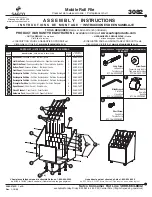
6
Signet 3719 pH/ORP Wet-Tap
If the piston does not retract easily, or if any fluid is observed leaking from the electrode
threads, the pipe must be drained before the 3719 can be safely removed.
• Stop the flow and depressurize the pipe.
• Remove the entire 3719 assembly from the pipe.
• Remove the electrode from the assembly
• Clean any scaling and debris found on or in the piston tip and surrounding area.
Cleaning
Cleaning techniques vary depending on the type of coating present on the glass electrode surface or reference junction.
•
Remove soft coatings by vigorous stirring, or with directed spray of a suitable detergent or solvent onto the glass electrode surface.
•
Use chlorine bleach or mild detergent to remove soft coatings. Rinse electrode tip in clean water after cleaning.
•
Use the least harsh chemical available to remove hard coatings without attacking the materials of construction.
(For example, remove calcium carbonate with a 5% HCL (muriatic acid) solution.
•
Remove oily or organic coatings with detergents or an appropriate solvent that does not attack the materials of construction.
•
ORP electrode surface (platinum) can be gently sanded with 600 grit wet and dry silicone or carbide sandpaper, jewelers rouge,
crocus cloth, or very fine steel wool.
•
Never scrape or sand the glass electrode surface.
•
Treat glass electrode surfaces with appropriate care to avoid breakage.
6. Electrode Maintenance and Cleaning
5.6 Electrode removal
The electrode in any pH or ORP system
requires periodic service, calibration or
replacement. When removing the electrode
from the wet-tap assembly, it is very
important to exercise caution and follow the
instructions carefully.
1.
Remove the preamplifier from the top
of the wet-tap assembly.
2.
Turn the locking shroud
1
/
4
-turn
clockwise to unlock the piston.
3.
Pull up on the locking shroud to retract
the electrode piston into the pipe.
DANGER!
The piston should retract easily from a pressurized
pipe. If the piston offers resistance, there is a danger
that the piston is coated with deposits from the process.
STOP! DO NOT FORCE THE PISTON UP!
It may damage the O-rings or break off the piston tip.
Return the locking shroud to the LOCKED position
and follow the steps in the box below.
4.
Turn the locking shroud ¼-turn
counterclockwise and lift up to remove it
from the wet-tap assembly.
5.
Remove the electrode by turning it counterclockwise.
For safety, keep your body clear of the top of the wet-tap assembly while removing the electrode.
DANGER!
If any fluid is observed leaking from the electrode threads, STOP! DO NOT REMOVE THE ELECTRODE. There is a danger
that the piston tip has been damaged.
Tighten the electrode back down to reseal the assembly and follow the steps in the box below.
2
3
4
5
1
5
3


























